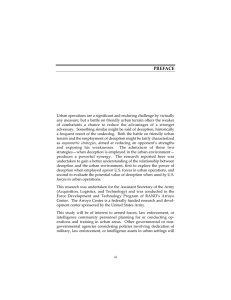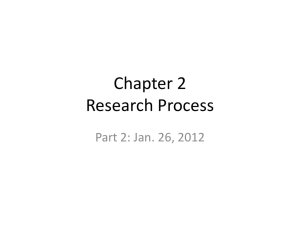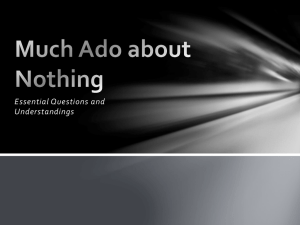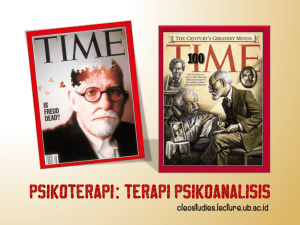THE ROLE OF DECEPTION IN URBAN OPERATIONS Chapter Four
advertisement
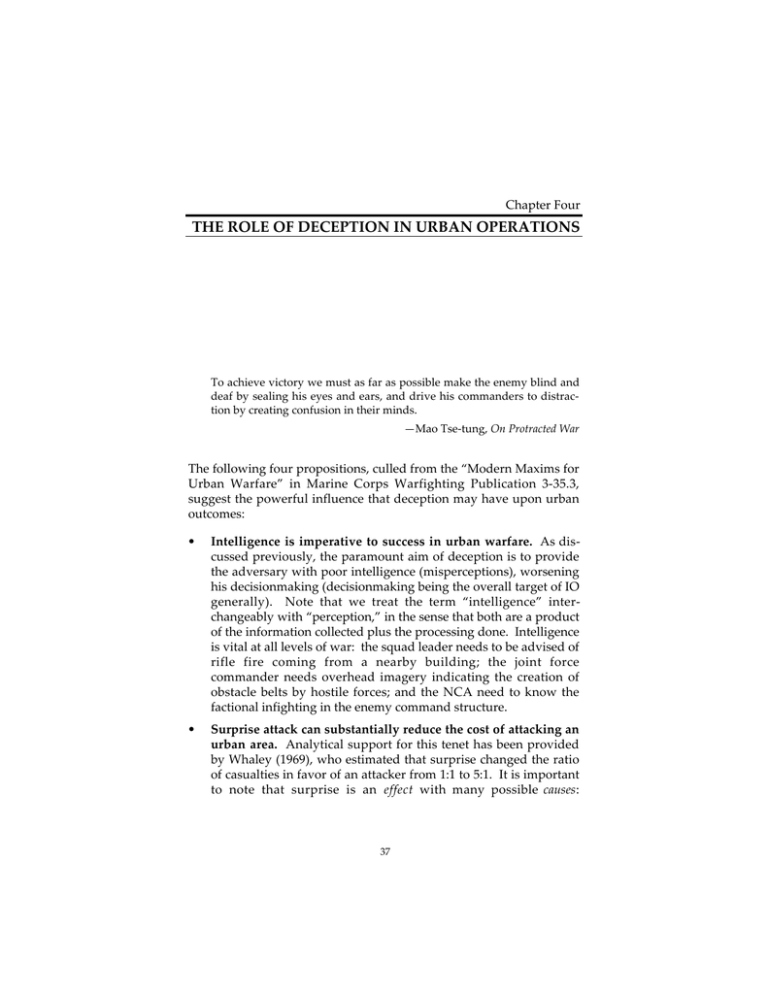
Chapter Four THE ROLE OF DECEPTION IN URBAN OPERATIONS To achieve victory we must as far as possible make the enemy blind and deaf by sealing his eyes and ears, and drive his commanders to distraction by creating confusion in their minds. —Mao Tse-tung, On Protracted War The following four propositions, culled from the “Modern Maxims for Urban Warfare” in Marine Corps Warfighting Publication 3-35.3, suggest the powerful influence that deception may have upon urban outcomes: • Intelligence is imperative to success in urban warfare. As discussed previously, the paramount aim of deception is to provide the adversary with poor intelligence (misperceptions), worsening his decisionmaking (decisionmaking being the overall target of IO generally). Note that we treat the term “intelligence” interchangeably with “perception,” in the sense that both are a product of the information collected plus the processing done. Intelligence is vital at all levels of war: the squad leader needs to be advised of rifle fire coming from a nearby building; the joint force commander needs overhead imagery indicating the creation of obstacle belts by hostile forces; and the NCA need to know the factional infighting in the enemy command structure. • Surprise attack can substantially reduce the cost of attacking an urban area. Analytical support for this tenet has been provided by Whaley (1969), who estimated that surprise changed the ratio of casualties in favor of an attacker from 1:1 to 5:1. It is important to note that surprise is an effect with many possible causes: 37 38 The Art of Darkness: Deception and Urban Operations deception is but one. Technological or doctrinal innovations, tight secrecy, and a sluggish adversary can also beget surprise. However, deception is increasingly the surest effector of surprise. In Barton Whaley’s magnum opus Stratagem (1969), he notes that in 68 major battles between 1914 and 1967, the incidence of surprise (where present) became steadily more reliant upon deception. • Surprise is a combat multiplier for both the attacker and defender. Virtually every military theorist, from Frontinus to Liddell-Hart, would agree with this proposition. Analytical support for it is provided by DePuy (1978), who estimated that the element of surprise doubled the combat power of those who had it. Betts (1983) has made similar points, relating to the induction of paralysis when surprise is effected. Deception has emerged as the preeminent “midwife of surprise” (Harris, 1970) at the end of the 20th century, and thus it plays a vital role in any doctrine calling for surprise. • Media coverage of urban warfare can have operational or strategic impact. The propagation of deception to the intended target via news and other media has a long and storied past. However, the use of deception to influence and manage the media has also proved to be a valuable objective. It seems clear that current doctrine on urban operations not only allows for, but indeed actively prescribes, measures that may worsen enemy decisionmaking, leave an enemy ripe for surprise, and influence media coverage in a manner favorable to friendly forces. Deception ably fits the job description. WHAT KIND OF URBAN OPERATIONS IS DECEPTION APPLICABLE TO? It would be an exaggeration to say that successful deception by itself enables wars to be won. But it is precisely when the resources are stretched and the tasks many, when the forces are evenly matched and the issue trembles in the balance, that successful deception matters most. —David Dilks, Appeasement and Intelligence, quoted by Handel (1985) The Role of Deception in Urban Operations 39 Deception is a powerful instrument for virtually every type of urban operation, since to succeed nearly every one will require accurate intelligence, friendly (or at least neutral) news coverage, and perhaps surprise—in short, wherever the four Marine Corps maxims we quoted earlier may apply. However, we are cognizant that the mission undertaken, the stakes involved, and the facts on the ground may not allow “every trick in the book” to be used. This is particularly true if cost, deconfliction, and discovery concerns are nontrivial. For the weaker of two contenders, or for the side that has prior possession of the built-up area in question, deception pays potentially huge dividends for acceptable investments. This premise is relatively easy to accept given the earlier points about why a weaker combatant might seek to invite battle in urban terrain (if the urban environment increases one’s own combat power or decreases an opponent’s). Deception is similarly inviting: if deception can yield surprise, and surprise can significantly increase combat power, then the weaker side is likely to resort to deception. As proposed earlier, these independent asymmetric strategies may have cumulative or even synergistic effects. However, deception need not be remanded to the exclusive custody of David. Returning to the earlier example, imagine how differently the parable might have turned out had Goliath employed wit in addition to brawn. It may prove an illustrative exercise to construct a notional example of an urban operation with friendly forces projecting force, wherein deception is employed. This may better clarify the interrelationship between the deception and urban terrain, particularly insofar as Goliath might be concerned. Scenario: A U.S. joint task force is assigned the responsibility for the noncombatant evacuation operation (NEO) of several hundred Americans in a large port city within a nonaligned developing nation. The casus belli for the NEO is a breakdown in civic order and the eruption of factional strife in the city and its environs. The setting for the NEO is thus labeled semipermissive, with both organized and impromptu resistance expected, probably in the form of ambushes and raids featuring small arms and RPG fire. International organizations (including relief agencies and news media) are present, along with just shy of a million panicky noncombatants caught in the 40 The Art of Darkness: Deception and Urban Operations crossfire. Thus restrictive rules of engagement (ROE) are in place to avoid excessive noncombatant casualties and any other impolitic events. Traditional “clear and hold” sector-by-sector methods are inapplicable as an overall approach, given the size of the friendly force and the size of the built-up area. A speedy, penetrating thrust to the American citizens’ rallying point (an embassy, hotel, or the like) causing minimal collateral damage, yet ensuring the safety of the force, is a better bet. • What would deception be used for? Deception could be used to help achieve operational objectives: effecting surprise for friendly forces, drawing hostile forces away from rally points, turning hostile forces out of prepared positions, and the like. Tactical objectives can also be gained with the help of deception: concealing an axis of advance from hostile intelligence, catching hostage-takers off guard, drawing enemy fire away from friendly forces, and so on. Put another way, deception would be employed consonantly with IO objectives generally, and the Marine Corps maxims noted above specifically: that is, feeding the adversary poor intelligence, achieving operational and tactical surprise, and influencing the news media in a manner favorable to strategic and operational objectives. • Who would use deception? The friendly JTF commander and his or her staff could certainly make use of deception to help achieve operational objectives enumerated above. Smaller unit leaders and even individual soldiers could similarly make use of deception, in their case to achieve tactical objectives. • Is the context necessary for deception present? Reviewing the criteria listed in Chapter Three, pp. 26–27, the JTF commander plus his staff can definitively answer this question. Close coordination with friendly intelligence is critical in this assessment, underlining the directives found in Joint Pubs 3-13 and 3-58. In this case there are at least two sides in contention (friendly plus one or more adversaries plus noncombatants), and the adversaries and noncombatants are gathering information about the evolving situation, and the friendly force has the means at its disposal for transmitting information to the adversaries and noncombatants, and the adversaries and noncombatants won’t automatically “see right through” any falsehoods, and the adversaries and The Role of Deception in Urban Operations 41 noncombatants can actually modify their actions based upon information gathered. Deception may be gainfully employed in this scenario, given that concerns over cost, deconfliction, and discovery are not too great. While these criteria may sound stringent, in practice it is most often the case that they are fulfilled at one or more levels of war. • Can the process and means of deception be employed? At the operational level, with the objectives for any deceptions noted above, the JTF commander plus his staff must decide whether accessible decisionmakers (adversaries or neutrals) can be targeted and swayed by deception operations. If such targets exist, they ask, can the appropriate story be concocted, delivered, and digested by the target in a way that will engender useful and timely responses? If the answer to the preceding questions is yes, then deception surely offers itself as an important measure to assist the NEO. The example of the NEO is a useful one. It represents an emerging class of missions likely to be performed by U.S. forces, either alone or in concert; moreover, it is a simple exercise to extrapolate how the use of deception seen in this case might be applicable to smaller-scale contingencies as well as the higher end of the conflict spectrum. In sum, in any urban operation wherein enemy intelligence, media coverage, and surprise (with all its benefits) play a role, deception can perform an important function. HOW DOES URBAN TERRAIN ALTER DECEPTION? IRA volunteers operating in rural areas, wanting to blend in with the hedges, fields and trees, could wear such jackets, but they were not the gear for towns and villages. You had to blend in with the local population: you had to look like a mechanic, or a postman, or a bank clerk, not Fidel Castro. —Collins (1997, p. 171, emphasis added) In a previous section we noted several key differences between urban and other types of terrain. Likewise, deception methods and means vary between environments. It is a straightforward proposition, based upon our earlier discussion of the contextual requirements and 42 The Art of Darkness: Deception and Urban Operations process, that effective deceptions must be tailored to suit their context. In a rudimentary illustration of this principle, it stands to reason that camouflage useful in woodland settings is of little use in the midst of a steel-and-stone metropolis. The particular characteristics of the urban environment have a direct influence upon the implementation of deception methods, whether camouflage or decoy, diversion or disinformation. While little experimentation has been done to map the parameters of this phenomenon in military applications, some work has been done along these lines in animals (Erichsen, Krebs, and Houston, 1980). The case of camouflage in urban terrain is an interesting representative of deception more generally. Current Marine Corps doctrine (MCWP 3-35.3) is clear: To survive and win in combat in built-up areas, a unit should supplement cover and concealment with camouflage. To properly camouflage men, carriers, and equipment, Marines should study the surrounding area and make their fighting positions blend with the local terrain. What does this admonishment translate to in practice? What are the specific features of urban terrain relevant to camouflage? As noted in Schecter and Farrar (1983), “the texture of urban terrain is very abrupt, truncating line-of-sight envelopes severely from most locations,” meaning close detection ranges are the norm. Structures in built-up areas throw sharp shadows that shift during the day. Stone, brick, and masonry predominate, yet intermittent bursts of color are common: the particulars matter greatly and can vary from block to block. Soft, organic curves are far less frequent in urban terrain than in any other. Light penetrates poorly into the interiors of buildings. Smog, soot, dust, and haze are regular features of most urban cityscapes, and in conflict this is worsened by the presence of smoke. Therefore, camouflage in urban terrain—if it is to be useful—must account for all of these factors. It must be effective at the short ranges frequent in urban encounters, in shadows and broad daylight, in open air or choking dust, and against the singular color schemes of the cityscape. As noted by the U.S. Army Soldier Systems Center at Natick, Massachusetts, camouflage in urban terrain requires The Role of Deception in Urban Operations 43 smaller designs with closer merge distances. Also, urban backgrounds generally require more straight edge camouflage, vertical and horizontal designs to blend with homes, buildings and other urban structures, etc. Near infrared (NIR) camouflage for urban areas would generally mimic NIR spectral reflectance of road and building materials, asphalt, concrete, gravel, steel, brick, wood, stucco, etc. This would be in contrast to woodland NIR requirements that mimic the chlorophyll [spectral reflectance] curve of vegetation, and the NIR requirements of desert camouflage which mimics the [spectral reflectance] curves of desert sands. Other forms of deception are similarly influenced by their context, particularly by the key characteristics of urban terrain noted earlier. Generally speaking, deception is not only altered (as noted above), but significantly abetted when conducted on urban terrain. HOW DOES URBAN TERRAIN HELP DECEPTION? [S]etting traps: places where the [police] were always pulling raids. One of our girls would call them up and say “Listen, there’s been a burglary at a drug store. Why don’t you send a radio car over?” And then these two radio cars would come by and everyone would be standing by the corner with rocks and molotovs, and then: bang! —Baumann (1975, p. 52) Hypotheses on Deception in Urban Operations Judging from the characteristics of urban terrain, their effects upon operations, and the nature of deception, it appears that urban terrain amplifies the ease and effectiveness of deception in six key ways: The scope of deception is increased. The size and complexity of deception efforts in built-up areas is fundamentally increased. The axiom that urban terrain swallows units with an appetite unmatched by any other environment has a flip side: urban terrain can accommodate very large numbers of men and materiel. Recall the comment noted earlier by Ellefsen (1987) with regard to the multiplication of surface space within a city. The net effect of this is to greatly expand the physical and logical reaches of deception efforts in urban geography. For example, it may be possible to camouflage or conceal 44 The Art of Darkness: Deception and Urban Operations the presence of three companies of dismounts in an urban area, whereas only a single company might be concealed in a similar-sized area of desert. Similar questions arise with regard to vehicles and command posts: how much more can be concentrated and covered in an urban environment than in other environments? The Soviets recognized this principle in World War II, as noted by Matsulenko (1974): The city environment allowed for effective concealment and camouflage of massive concentrating forces . . . better than any other operating environments. No experimental data currently exist to quantify these phenomena, except in animal biology. As an interesting aside, the question of what effect the urban environment has on operational security, deconfliction, and logistical efforts also remains unanswered. “Background noise” provides an excellent framework for deception efforts. Confusion and complexity make intelligence efforts more difficult in general; deception exploits these features when possible. As Roberta Wohlstetter proposed in her analysis of Pearl Harbor (1962), skillful deception can capitalize upon inherent ambiguity and volume of indicators, “heightening the impression that evidence is indeterminate.” No operating environment is “noisier” than the city, with its surfeit of structures, avenues, radio and telephonic traffic, noncombatant vehicles and pedestrians, noise, and heat. Not only is it difficult to discern militarily important “signals” from the ambient “noise,” but a wily adversary will deliberately foster more such clamor and cloak his activities and intentions behind that backdrop. But in addition to enhancing concealment, there may be some interesting effects in the other direction as well. To recall an earlier example, the crying wolf ploy is an active attempt to reduce an adversary’s readiness and vigilance through repetitive, visible “exercises.” Is crying wolf easier or harder to accomplish in an urban environment than in others? Are intelligence analysts who scrutinize the city more or less prone to be searching for preconceived patterns than those looking at other environments? Once again, no experimental data exist to quantify how urbanized terrain affects the concealing or revealing of deceptions in built-up areas. The Role of Deception in Urban Operations 45 The city is a rich source of material resources for deception. Deception requires varying degrees of investment, and investment requires resources. While some combatants may have the requisite materials in their own inventory, others will have to exploit some aspect of the local environment. Built-up areas (particularly cities) provide a lode of material wealth not found in any other environment: communications and energy infrastructure, manufacturing facilities and fabric, vehicles and scrap, printing and xerographic facilities, paints, fuels, weapons and explosives, and of course, noncombatants and organizations of every stripe. Whether the deception method in question is camouflage, decoy, diversion, disinformation, or something else, the physical and contextual requirements to carry it off are more likely to be present in urban terrain than in any other. A superb example of this is recounted by Roy Stanley (1998, p. 171), describing the masterwork of camouflage undertaken in 1942 to protect the Douglas Aircraft Company factory in Santa Monica, California, from the threat of Japanese bombing: A key factor in this story was the special pool of talent available in Hollywood, all eager to help the war effort. Movie studios were full of experts in creating illusion and they had the tools, experience, skills and enthusiasm. They understood how to use wood, wire, plaster and paint to shape or reshape something. The Germans took similar advantage of Italian movie studios in creating deceptions at Anzio. While certainly not all built-up areas will have local Hollywoods, they will all have reservoirs of men and materiel in the noncombatant population and infrastructure unavailable to combatants in any other type of terrain. This could be as simple (but powerful) as Xerox machines and department store mannequins, from which a hundred clever deceptions might be wrought. Decisionmaking is hastier and generally less informed in built-up areas. As clearly indicated in JP 3-13, Joint Doctrine for Information Operations, worsening an opponent’s decision-making process is a powerful enhancement to operations—and the stated goal of all offensive IO measures (including deception). As noted earlier, urban operations feature degraded command and control (C2), great stress, and a high operational tempo. In other words, combatants’ decisionmaking is adversely affected just by participating in urban operations. Specifically, a high operational tempo necessitates that unit 46 The Art of Darkness: Deception and Urban Operations leaders make faster decisions, and degraded C2 implies that the intelligence picture remains incomplete during those decisions. This is fertile ground for deceivers. Consider, as noted in the contextual requirements for deception, that a less-informed adversary is more gullible. Consider also the Marine Corps maxim calling for intelligence as an essential component to success in urban operations. Deception injects false indicators into an already poorly “intelligenced” environment. For example, given the importance of navigation and orientation in the complex urban environment, maps make an excellent subject of disinformation campaigns: In the 1930s, after the NKVD, or security police, assumed control of mapmaking, the Soviet cartographic bureaucracy began to deliberately distort the position and form of villages, coastlines, rivers, highways, railroads, buildings, boundaries and other features shown on maps and atlases for public use. (Monmonier, 1996, p. 115.) In a fast-paced urban operation, the need for speedy decisions worsens a target’s ability to discount false indicators (Schul, Burnstein, and Bardi, 1996; Fein and Hilton, 1994). Moreover, less-informed individuals are generally less able to penetrate deceptions than moreinformed individuals (Anderson, Lepper, and Ross, 1980). The presence of noncombatants significantly worsens the capability of discerning friend from foe, and combatant from noncombatant. The presence of noncombatants in great numbers and great variety creates significant challenges for forces in urban operations. One such challenge is the generation of “background noise” mentioned above, but another is in greatly increasing the difficulty of establishing who’s who on the battlefield. This observation is confirmed by West German terrorist Michael Baumann (1975, p. 54): The Berlin police were looking for hundreds of groups and sects . . . when all along it was the same crew, who adopted a new name every week. Rules of engagement (ROE) generally require that noncombatants remain unmolested, and thus it is incumbent upon U.S. forces to establish identity before engaging any target. Noncombatants appear on the urban battlefield with greater frequency and in greater numbers than in any other environment, and thus the burden upon U.S. The Role of Deception in Urban Operations 47 forces to establish identity is heavier. Not every detection is an enemy to be fired upon, and the diversity of a city’s population creates ample opportunities for adversaries to disguise themselves. Moreover, knowing that U.S. forces will be reluctant to fire upon noncombatants, adversaries are likely to deliberately mix with civilian populations to camouflage their presence. This is true in any case, but it is a particularly vexing problem for the side to whom the noncombatant population is unfriendly. An excellent example of this is illustrated by Christmas (1977, p. 23) in his description of the Marines fighting in Hue City, 1968: [T]he company had been warned that Viet Cong units occupied the hospital and might pose as patients. They did! In fact, more than one Marine was fired on by “patients,” but they were ready for such surprises. A Marine encountered a person wearing a black habit whom he believed to be a nun. He could not have been more wrong. Fortunately the nun’s pistol misfired and the Marine’s life was spared. The nun was a Viet Cong soldier. Ruthless adversaries are also likely to employ noncombatants as living decoys and diversions, further complicating the picture for U.S. forces. These techniques have great offensive and defensive value, allowing adversaries to materialize close to friendly forces with alarming speed, and to disappear just as quickly into the teeming city. Consider the following example (drawn from a 1991 attack on the British Prime Minister by the IRA): The Mark 10 mortar, cunningly constructed from three oxyacetylene cylinders and arranged on a rack with rubber collars at their base to cushion the recoil, could be hidden in a van. The propellant, made from sugar and sodium chlorate, would send the projectiles, each packed with forty pounds of industrial explosive, in a predetermined arc . . . To the innocent eye the [nondescript] van would not even seem to be near the heavily protected buildings two hundred yards away . . . So on the morning of February 7, 1991, with the roof cut open, with the mortars ready, with the timer fuse ready, the van was driven through an unexpected snow to a site two hundred yards away from Downing Street [the British Prime Minister’s residence]. The driver parked, got out into the snow, walked a few steps and jumped on the [rear seat] of a waiting motorcycle. The short timer was running. (Bell, 1997, pp. 623–624.) 48 The Art of Darkness: Deception and Urban Operations Note how deceptive elements and features of urban terrain so easily intermix. Could a mortar be easily driven to within 200 yards of a country’s leadership in any other kind of terrain? Could the weapon be leisurely armed and left to fire without causing even a raised eyebrow, unless it was concealed in an unassuming van? Could the attackers so easily and quickly escape in any other kind of environment? Urban clutter blunts the edge of technology, particularly with regard to sensors and communications. Technological preeminence is exploited to the hilt in current and future U.S. doctrine. The technological disparity between U.S. forces and potential adversaries— and the resulting advantages accrued—varies with the terrain. Jungles tighten the gap while deserts widen it, but nowhere is the margin slimmer than in built-up areas. Sensors and communications operate less reliably and at reduced power in urban terrain. This fundamentally affects deception by reducing the number and power of intelligence channels available to the target. Of IMINT, SIGINT, HUMINT, COMINT, and MASINT, one or more may be indeterminate, occluded, or untrustworthy. Parenthetically, HUMINT sources may in fact be multiplied greatly in the urban environment, although the trustworthiness and quality of those sources is not at all assured. That said, multiple channels of corroborating intelligence are vital to the penetration of deception. If these intelligence channels are less reliable or absent altogether, vulnerability to deception is increased. The net result of these six effects is twofold. First, while deception is widely understood to be a powerful tool under many circumstances, it is particularly effective in the urban environment, and can be gainfully employed by either side. Second, the weaker of any combatants will assuredly seek to make use of deception, particularly if they are in prior possession of the built-up area, and/or have a friendly relationship with the noncombatant population. This latter assertion is concordant with the tenets of an “asymmetric approach” described earlier. The Role of Deception in Urban Operations 49 Historical Support for Hypotheses The most powerful weapon of war is the unexpected. —Julius Caesar, Commentarii de Bello Gallico There is ample historical evidence for the potent admixture of deception plus the urban environment, although there is virtually no experimental data to attempt to measure the impact. Detailed historical case studies are beyond the scope of this report, but a brief look at some recent urban campaigns will prove illustrative. Table 2 introduces this section with a cursory tabulation and comparison of the role of deception in three such urban campaigns. Battle for Grozny In Chechnya, Russia: January 1995. In late 1994, Russian forces mobilized to stem the separatist tide in the republic of Chechnya. Throughout the month of January 1995, Russian forces fought insurgent Chechens in the streets of the capital city Grozny in a bloody and difficult battle that could fairly be characterized as an unmitigated disaster for Russian forces on their own soil (Thomas, 1997; Lieven, 1998; Gall and De Waal, 1998). The already great challenges of operating in urban terrain against an implacable insurgent force were heightened by Russian failures to train and organize properly, to ensure good intelligence collection and dissemination, to implement good command and control (C2), and to influence the media favorably. The preceding list eerily echoes the discussion earlier of areas that may be exploited by deception methods: the Chechens made good use of these vulnerabilities. From the start, they baited the more-powerful Russian force with an appearance of weakness: To all appearances, the Chechen preparations were [worthless], their mission suicidal. As the Russian tanks ranged across the hills to the north of Grozny, attacking a line of villages . . . the Chechens appeared to be doing little to prepare defenses. (Gall and De Waal, 1998, p. 189.) 50 The Art of Darkness: Deception and Urban Operations Table 2 A Look at Hypotheses in Selected Urban Conflicts Grozny 1995 Lima, 1985–1989 Belfast/Derry, 1969–1989 Increased scope of deceptions MTW; thousands of Chechen fighters exploiting deception successfully to confuse and entrap Russians and to force-protect Terror campaign; hundreds of Sendero Luminoso (SL) operatives organize, recruit, train, plan, and strike in Lima aided by deception Long-lived terror campaign; hundreds of IRA Provos bomb, snipe, infil/exfil, organize, and persist aided by deception High-volume background noise MTW; city in complete chaos Tumult of a major metropolis with massive slums; discord deliberately intensified by SL Profusion of targets (across UK) and decentralized nature of IRA create difficulties for British Increased resources available in urban environment News media; civilian commo; printing presses; weapons, vehicles; clothes; fuel; HUMINT; etc. Vehicles; clothes; fuel; printing presses; weapons, HUMINT; etc. Money; weapons; vehicles; clothes; fuel; news media; civilian commo; printing presses; Catholic safehouses; HUMINT; etc. Worsened decisionmaking Poor Russian C2; Russians surprised Peruvian intelligence forced to double and redouble assets to cope with deception British learn from early failures and difficulties, yet persistent utility of deception for IRA Great numbers of noncombatants present Tens of thousands unfriendly to Russian troops; ROE attempted; NGOs present Hundreds of thousands of poor and alienated peasants in slums Noncombatants are both geographically as well as ideologically divided; ROE for British Technological edges blunted Commo degraded; intel sensors degraded; armor vulnerable; weapons less effective; etc. Not as serious a problem for government as “background noise” issue Measure versus countermeasure race established; an exception: night vision for British always useful The Role of Deception in Urban Operations 51 Chechens employed deception at both the strategic and tactical levels of war with great effect (Thomas, 1997; Lieven, 1998). At the tactical level, Chechen fighters and Ukrainian mercenaries disguised themselves and their vehicles as Russian or noncombatant (including Red Cross); commingled forces with noncombatant crowds and activities when moving in advance or retreat; camouflaged firing points, command posts, and other important sites; employed decoys and dummies to draw fire or confuse Russian intelligence; and transmitted false radio broadcasts to misdirect and disorient Russian troops. At the strategic level, the Chechens assiduously courted the media with a disinformation campaign to present a prejudicial view of the situation; disguised and dispersed forces in and out of theater for intelligence-gathering forays; and targeted neighboring republics’ civil and military leaders with disinformation to attempt to widen the war and pin down Russian troops elsewhere. Sergei Stepashin, then head of Russian domestic intelligence (the FSK) and former Russian Prime Minister, made this sardonic observation at the time: Yes, the Russian administration has lost the information war. How brilliantly the Chechnyan Minister of Information Movladi Udugov works, how artfully and easily he releases to the press any distortion, lie, juggling of the facts . . . (Quoted in Lieven, 1998, p. 120.) While the Russians too employed deceptive techniques during the battle for Grozny, sometimes effectively, the Chechens appear to have truly multiplied their combat power by its use. The Russians failed to meet the operational challenges presented by urban terrain and, moreover, failed to ameliorate the specific vulnerabilities to deception noted earlier. This vulnerability to deception efforts (and the Chechen exploitation of it) is responsible, at least in part, for the catastrophic defeat suffered by the Russians in the battle of Grozny. Urban Campaign of the Sendero Luminoso in Lima, Peru: 1985– 1989. Urban terrorism and guerrilla action has a long and venerable tradition in Latin America, playing key roles in Uruguayan (1965– 1973), Brazilian (1968–1970), and Argentinean (1970–1976) insurgencies (Marighella, 1968; Jenkins, 1971; Miller, 1980). Urban actions also contributed to Cuban, Guatemalan, and Venezuelan insurgencies between 1957 and 1974 (O’Neill, Heaton, and Alberts, 1980). A more recent and particularly tenacious urban campaign has been waged by the Sendero Luminoso (SL), a devoutly Maoist-Leninist revolutionary 52 The Art of Darkness: Deception and Urban Operations group in Peru (McCormick, 1990, 1992). SL (which is still active, though weakened by the decapitation of the organization) has engaged in activities ranging from bombings and assassinations to mobilizing massive demonstrations and propaganda releases in the course of their urban efforts. To operate and be effective in Lima, the capital and heart of the country, SL has employed numerous forms of deception at all levels of war (McCormick, 1990, 1992; Centro de Estudios y Promoción del Desarollo). To achieve its tactical objectives, SL has employed camouflaged sniping positions, disguises and forged identities, diversionary explosions, and the like. At the strategic level, SL has deliberately sought to cloak its activities in the noisy environment of the city, and even to intensify that “background noise” to further befuddle Peruvian intelligence (Sendero Luminoso Documents, 1982, 1987, 1988; Guzman, 1988). This strategy is concordant with the teachings of Carlos Marighella (1968), the premier theoretician of urban guerrilla warfare in the 1960s and 1970s: By making expropriations seem the work of bandits and by avoiding identifying themselves and their origins, the Brazilian revolutionaries managed to gain time by keeping the authorities in a state of uncertainty, preventing them from following specific trails. The unique characteristics of the city, its slums and teeming population, its news media and physical resources, its profusion of activity and traffic—all have served the SL’s purposes in promoting its actions and shielding its operatives from detection and neutralization. Urban Campaign of the Provisional IRA in Belfast/Londonderry: 1969–1989. Since 1916, Irish Republicans determined to gain independence from the British have waged an episodic, evolving campaign for a self-governing, predominately Catholic Northern Ireland. Beginning in 1969–1970 with the formation of the Provisional wing of the IRA, the Republicans brought their efforts to urban centers such as Belfast and Londonderry in earnest. As described by Bell (1997, p. 378), the aggressive British responses to these urban efforts encouraged the IRA to move from a defensive to an offensive campaign. By employing against the IRA the “appropriate” tactics to counter an urban guerrilla campaign, the British Army largely transformed the rocks and riots of 1969 and 1970 into a very real, if The Role of Deception in Urban Operations 53 low-intensity, war the following year, with snipers, car-bombs, shootouts in housing estates, and battles on the border. With the intensification of the urban conflict, IRA strategies began to employ deception efforts in a widespread way (Bell, 1991; Dewar, 1992). Deception was employed tactically to assist in the execution of direct action missions: IRA operatives employed disguises and proxies for intelligence gathering and infiltration/exfiltration of active service units (ASU) (Collins, 1997); and diversionary activities (explosions, shots, etc.) were used to draw British/Loyalist forces both away from IRA operatives and toward ambushes. In an example of deception employed at the strategic level, Provisionals fed disinformation (by pamphlet, doctored photo, radio broadcast, etc.) to religious, cultural, civic, and military leaders in order to alienate the British and Loyalists from the noncombatant population (Collins, 1997). At the operational level, IRA activities were also organized somewhat to foment urban “background noise” when and where needed, as well as to establish patterns of activity to be perceived by British forces. This latter bit of artifice was attempted because the Republicans could exploit the time element of their urban campaign: as noted in the discussion of deception earlier, patterns may be established only to be broken at a choice moment, often to gain tactical or operational surprise (Axelrod, 1979). An extended length of time was not the only factor to be capitalized upon by the IRA. The Provisionals benefited substantially from the presence of a friendly noncombatant population (predominately Catholic) in enclaves, who were alienated from the British. Some Catholic areas became virtually no-go to British forces. Moreover, in the early phases of the urban campaign, IRA forces tactically exploited weaknesses in British command and control, lack of intelligence, and alienation from the population to great effect. As noted by Dewar (1992, p. 158), [f]rom 1969 to 1971 patrolling was reactive rather than preventive. Battalions had some difficulty in even keeping up with the pace of events; they were seldom able to take the initiative. As the years passed, however, patrolling maps were updated, and the sheer volume of intelligence on the inhabitants of the battalion or company area of responsibility provided such a degree of background 54 The Art of Darkness: Deception and Urban Operations information that patrol commanders were able to put a name to most of the faces they passed on the street. These improvements significantly diminished (but did not altogether eliminate) British forces’ vulnerability to deceptions—a success story in countering an opponent’s deception efforts. As a side note, the IRA were not alone in employing deception methods to gain their objectives. Eamon Collins, a former intelligence officer in the IRA, related (1997, p. 168) that [m]y job in Customs gave me opportunities to drive around Bessbrook inconspicuously. I had spotted unmarked Sherpa vans leaving the barracks containing [British] soldiers in plain clothes, obviously involved in covert SAS operations . . . HOW MIGHT URBAN TERRAIN HINDER DECEPTION? Insofar as urban terrain may adversely affect the conduct of deception, it most likely sharpens the difficulties of using deception in two categories mentioned earlier, namely, cost and deconfliction. Discovery, the penetration by an adversary of a ruse, is potentially devastating regardless of the environment it occurs in. While the employment of deception is never cost free, it may prove more expensive in time, manpower, and resources in an urban environment. For example, the close detection ranges, discontinuous color schemes, wide variation in visibility, and manifold observation angles found in urban terrain may require that camouflage or decoys be made more lifelike (and thus more expensive) than their desert kin. Or it may be the case that establishing a visible pattern (to effect the crying wolf ploy) is more difficult against the cacophony of city activities than in the stillness of the desert. These questions beg experimentation and analysis. Urban terrain, in comparison with desert terrain for example, is a treasure trove of intelligence sources; SIGINT, COMINT, IMINT, MASINT, and especially HUMINT channels are frequently all available to combatants. However, as noted above, this glut is a noisy background against which to search for authentic signals. This probably raises the level of coordination and oversight necessary in the urban environment for one side to deceive the other successfully, The Role of Deception in Urban Operations 55 as well as to prevent its own or nonaligned forces from inadvertently collecting and believing a deception story.
